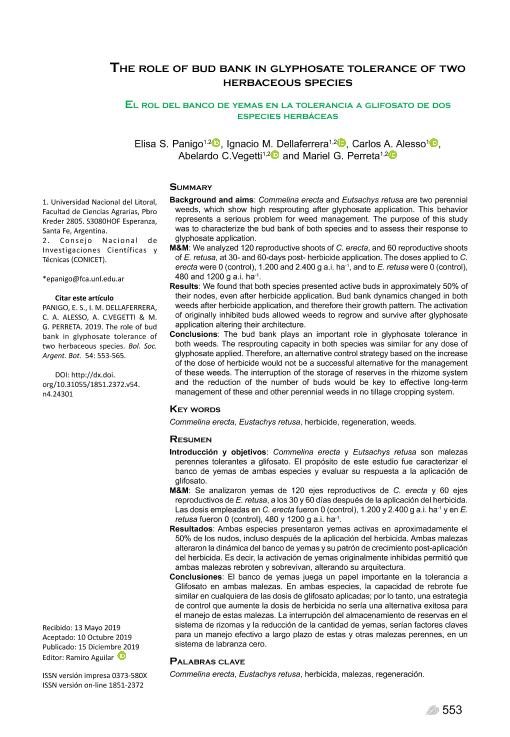Mostrar el registro sencillo del ítem
dc.contributor.author
Panigo, Elisa

dc.contributor.author
Dellaferrera, Ignacio Miguel

dc.contributor.author
Alesso, Carlos Agustín

dc.contributor.author
Vegetti, Abelardo Carlos

dc.contributor.author
Perreta, Mariel Gladis

dc.date.available
2022-02-14T12:35:11Z
dc.date.issued
2019-12
dc.identifier.citation
Panigo, Elisa; Dellaferrera, Ignacio Miguel; Alesso, Carlos Agustín; Vegetti, Abelardo Carlos; Perreta, Mariel Gladis; The role of bud bank in glyphosate tolerance of two herbaceous species; Sociedad Argentina de Botánica; Boletín de la Sociedad Argentina de Botánica; 54; 4; 12-2019; 553-565
dc.identifier.issn
0373-580X
dc.identifier.uri
http://hdl.handle.net/11336/151910
dc.description.abstract
Introducción y objetivos: Commelina erecta y Eutsachys retusa son malezas perennes tolerantes a glifosato. El propósito de este estudio fue caracterizar el banco de yemas de ambas especies y evaluar su respuesta a la aplicación de glifosato. M&M: Se analizaron yemas de 120 ejes reproductivos de C. erecta y 60 ejes reproductivos de E. retusa, a los 30 y 60 días después de la aplicación del herbicida. Las dosis empleadas en C. erecta fueron 0 (control), 1.200 y 2.400 g a.i. ha-1 y en E. retusa fueron 0 (control), 480 y 1200 g a.i. ha-1. Resultados: Ambas especies presentaron yemas activas en aproximadamente el 50% de los nudos, incluso después de la aplicación del herbicida. Ambas malezas alteraron la dinámica del banco de yemas y su patrón de crecimiento post-aplicación del herbicida. Es decir, la activación de yemas originalmente inhibidas permitió que ambas malezas rebroten y sobrevivan, alterando su arquitectura. Conclusiones: El banco de yemas juega un papel importante en la tolerancia a Glifosato en ambas malezas. En ambas especies, la capacidad de rebrote fue similar en cualquiera de las dosis de glifosato aplicadas; por lo tanto, una estrategia de control que aumente la dosis de herbicida no sería una alternativa exitosa para el manejo de estas malezas. La interrupción del almacenamiento de reservas en el sistema de rizomas y la reducción de la cantidad de yemas, serían factores claves para un manejo efectivo a largo plazo de estas y otras malezas perennes, en un sistema de labranza cero.
dc.description.abstract
Background and aims: Commelina erecta and Eutsachys retusa are two perennial weeds, which show high resprouting after glyphosate application. This behavior represents a serious problem for weed management. The purpose of this study was to characterize the bud bank of both species and to assess their response to glyphosate application. M&M: We analyzed 120 reproductive shoots of C. erecta, and 60 reproductive shoots of E. retusa, at 30- and 60-days post- herbicide application. The doses applied to C. erecta were 0 (control), 1.200 and 2.400 g a.i. ha-1, and to E. retusa were 0 (control), 480 and 1200 g a.i. ha-1. Results: We found that both species presented active buds in approximately 50% of their nodes, even after herbicide application. Bud bank dynamics changed in both weeds after herbicide application, and therefore their growth pattern. The activation of originally inhibited buds allowed weeds to regrow and survive after glyphosate application altering their architecture. Conclusions: The bud bank plays an important role in glyphosate tolerance in both weeds. The resprouting capacity in both species was similar for any dose of glyphosate applied. Therefore, an alternative control strategy based on the increase of the dose of herbicide would not be a successful alternative for the management of these weeds. The interruption of the storage of reserves in the rhizome system and the reduction of the number of buds would be key to effective long-term management of these and other perennial weeds in no tillage cropping system.
dc.format
application/pdf
dc.language.iso
eng
dc.publisher
Sociedad Argentina de Botánica

dc.rights
info:eu-repo/semantics/openAccess
dc.rights.uri
https://creativecommons.org/licenses/by-nc-sa/2.5/ar/
dc.subject
Commelina erecta,
dc.subject
Eustachys retusa,
dc.subject
herbicide,
dc.subject
regeneration,
dc.subject
weeds
dc.subject.classification
Agricultura

dc.subject.classification
Agricultura, Silvicultura y Pesca

dc.subject.classification
CIENCIAS AGRÍCOLAS

dc.subject.classification
Ciencias de las Plantas, Botánica

dc.subject.classification
Ciencias Biológicas

dc.subject.classification
CIENCIAS NATURALES Y EXACTAS

dc.title
The role of bud bank in glyphosate tolerance of two herbaceous species
dc.title
El rol del banco de yemas en la tolerancia a glifosato de dos especies herbáceas
dc.type
info:eu-repo/semantics/article
dc.type
info:ar-repo/semantics/artículo
dc.type
info:eu-repo/semantics/publishedVersion
dc.date.updated
2020-11-27T18:46:40Z
dc.identifier.eissn
1851-2372
dc.journal.volume
54
dc.journal.number
4
dc.journal.pagination
553-565
dc.journal.pais
Argentina

dc.journal.ciudad
Córdoba
dc.description.fil
Fil: Panigo, Elisa. Universidad Nacional del Litoral. Facultad de Cs.Agrarias. Departamento de Biologia Vegetal; Argentina. Consejo Nacional de Investigaciones Científicas y Técnicas. Centro Científico Tecnológico Conicet - Santa Fe; Argentina
dc.description.fil
Fil: Dellaferrera, Ignacio Miguel. Universidad Nacional del Litoral. Facultad de Cs.Agrarias. Departamento de Biologia Vegetal; Argentina. Consejo Nacional de Investigaciones Científicas y Técnicas. Centro Científico Tecnológico Conicet - Santa Fe; Argentina
dc.description.fil
Fil: Alesso, Carlos Agustín. Universidad Nacional del Litoral. Facultad de Ciencias Agrarias; Argentina. Consejo Nacional de Investigaciones Científicas y Técnicas. Centro Científico Tecnológico Conicet - Santa Fe; Argentina
dc.description.fil
Fil: Vegetti, Abelardo Carlos. Universidad Nacional del Litoral. Facultad de Cs.Agrarias. Departamento de Biologia Vegetal; Argentina. Consejo Nacional de Investigaciones Científicas y Técnicas. Centro Científico Tecnológico Conicet - Santa Fe; Argentina
dc.description.fil
Fil: Perreta, Mariel Gladis. Universidad Nacional del Litoral. Facultad de Cs.Agrarias. Departamento de Biologia Vegetal; Argentina. Consejo Nacional de Investigaciones Científicas y Técnicas. Centro Científico Tecnológico Conicet - Santa Fe; Argentina
dc.journal.title
Boletín de la Sociedad Argentina de Botánica

dc.relation.alternativeid
info:eu-repo/semantics/altIdentifier/url/https://revistas.unc.edu.ar/index.php/BSAB/article/view/24301
Archivos asociados
